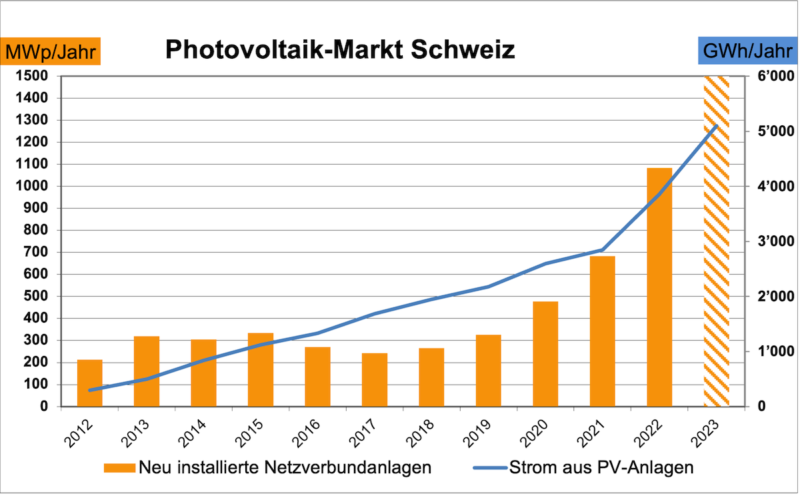
Inquiry
Switzerland: Solar Power Share Expected to Exceed 10% by 2024
The end of the year is a time for energy assessments, and the Swiss Association Swissolar is already looking ahead to 2024, predicting a solar power share of at least 10%.
Solar Power Production to Reach 6 TWh in 2024. By the end of 2023, Switzerland is expected to have installed over 6,200 MW of photovoltaic capacity, enabling a solar power production of approximately 6 TWh in 2024. This will surpass the threshold of 10% solar power share in Switzerland's annual electricity consumption. Swissolar had set this target for 2025 back in 2011.
Strong Growth in PV Installations Continued in 2023. Swissolar estimates that the new PV installations in 2023 will reach 1,500 MW, representing a market growth of nearly 40% compared to the previous year. This demonstrates the continued strong market growth of recent years.
Since 2017, when the revised Energy Act came into effect, the annual growth rate has more than doubled. These figures also indicate that, despite some challenges, the solar industry has been successful in recruiting the required skilled workforce. Policies and High Electricity Prices Drive Solar Power Boom in Switzerland. The estimates are based on registration numbers from the subsidy agency Pronovo and feedback from the market. The analysis shows that both the markets for smaller and larger installations have experienced significant growth.
The implementation of a new subsidy for installations without self-consumption (the so-called high one-time remuneration) has particularly boosted the market for larger installations. This has allowed projects like the optimized photovoltaic system on the retaining wall in Teufen, which generates electricity for approximately 50 households during the winter, to be realized.
Another major driver for capacity expansion has been the high electricity prices, similar to the previous year. This has affected large consumers who purchase electricity on the open market. However, even for regulated customers, the median price for electricity has increased by 28.5% from 2022 to 2023. (The median value is the central value in an ordered data set. Half of the electricity prices are above this value, and half are below it. The median is particularly meaningful in the presence of outliers, compared to the average, which can be heavily influenced by extreme values).
In addition, the increasing use of electric vehicles and heat pumps is promoting the adoption of photovoltaics. Many Swiss residents want to generate the additional electricity demand themselves, according to the association's conclusions.
Swissolar Forecasts Further Market Growth in 2024
Swissolar predicts a minimum market growth of 10% for 2024. This puts Switzerland on track to achieve the required annual capacity increase of over 2,000 MW by 2027. This increase is necessary for solar power to contribute to the goal of reaching 35 TWh of electricity from new renewable sources according to the Federal Council Dispatch.
Swissolar reported that the solar power share in Switzerland was 6.76% in 2022. Detailed solar energy statistics for Switzerland will be published on the industry association's website in the summer of the following year.
Our expert will reach you out if you have any questions!

